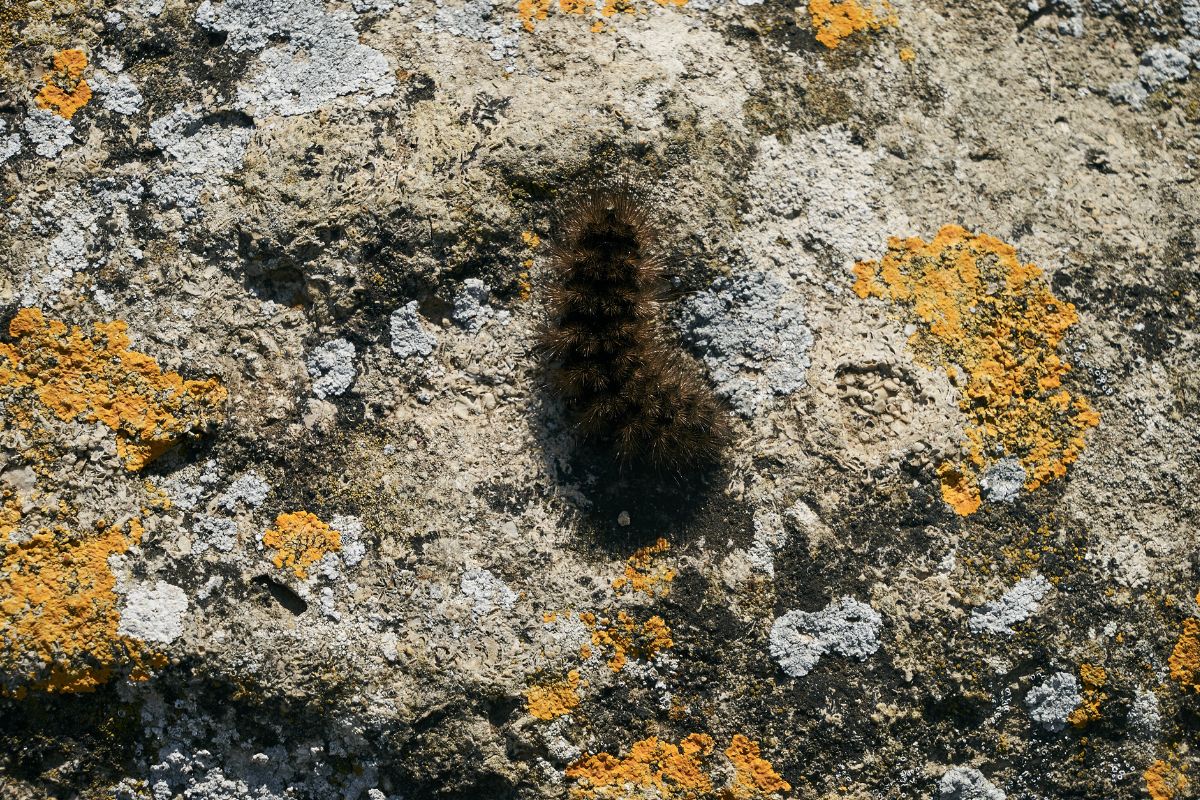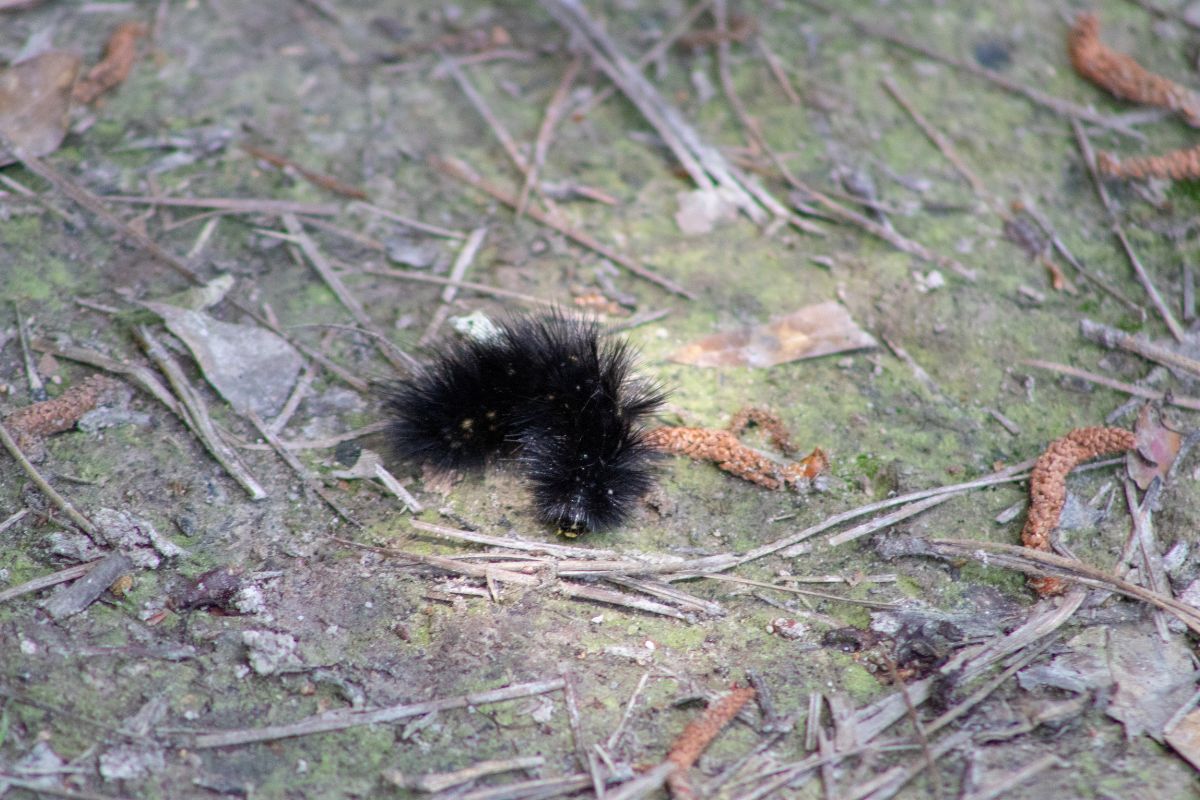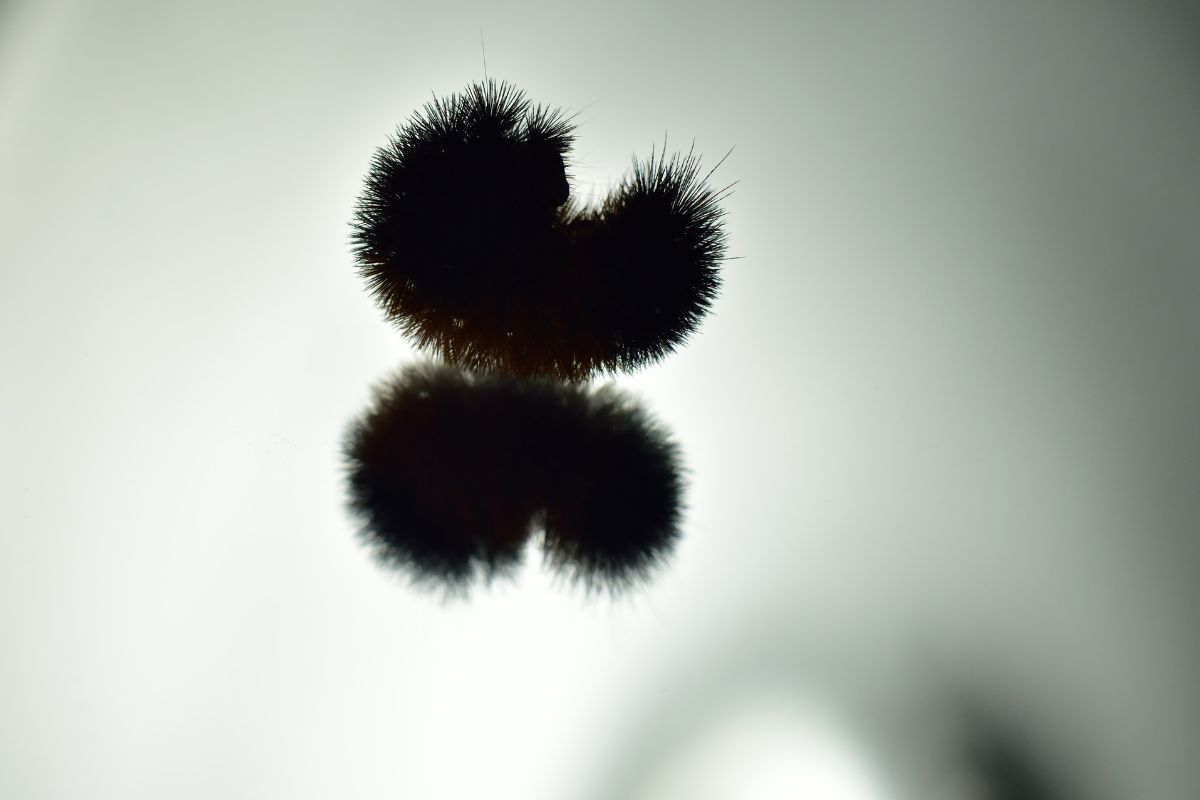What is an All-Black Woolly Worm?
Whenever you come across an all-black woolly worm, don’t panic because it is just a caterpillar from a different species and doesn’t foretell a severe endless winter.
This worm comes with a different name depending on your place of origin. Some refer to it as the fuzzy worms, woolly caterpillar, or woolly bear. Keep reading to learn more about the woolly worms.

What do Woolly Bear Caterpillars Eat?
The diet of a woolly bear caterpillar consists of various plants, herbs, and other things. They are primarily herbivores. Some of the variety of foods that woolly bear caterpillars consume in detail include the following:
Forbes, Grass, and Grains
Without their usual food sources, woolly bear caterpillars will eat grass and grains, including wild grasses, and cultivated grains like maize and barley are among those plants. They will only eat grasses in their leafy green stage since they only eat the leaves.
Herbaceous plants
A woolly caterpillar prefers to eat low-growing, seed-bearing plants with leaves rather than blades. Their favorite meals include lamb quarters, violets, clovers, dandelions, nettles, burdock, yellow dock, curly dock, and other wild plants.
Additionally, they consume, on occasion, sunflowers as well as other leafy garden plants, including spinach, cabbage, different greens, and garden herbs.
Tannins and Trees
Even though woolly bear caterpillars prefer to stay on the ground, they occasionally graze on the leaves of plants and trees. They have little to no interest in fruit and ornamental trees and instead like the sweet flavor of maple, elm, and birch tree leaves.
The Life Cycle of the Woolly Bear Caterpillar
You may be asking yourself what the woolly bear caterpillar life cycle is. Well, don’t worry because, in this section, you will learn about these fuzzy worms and their process. The woolly bear caterpillar is the larva phase of the Isabella Tiger Moth.
The woolly bear begins to thaw out as the temperature increases in the spring. They rise, eat for a few nights, and prepare a cocoon. Once you enclose, caterpillars transform into pupae in their cocoon.
In addition to that, the moths appear after a month. The moths are tan or orange, with fuzzy heads and multiple little black patterns on their wings. They do not eat. They only live a few days after mating and laying eggs before dying. Within two weeks, the new eggs hatch, and the life cycle begins again.
What do Woolly Bear Caterpillars Turn Into?
As with moths, one stage may be more visible than the others, and the adults and caterpillars may even have different names.
The famous rust-and-black-banded woolly bear caterpillar turns into the Isabella tiger moth, a magnificent, less-common, caramel-colored, cream-colored, or yellow moth (Pyrrharctia Isabella). Pyrrharctia is a “monotypic genus,” with only one species in North America.
Varieties of Woolly Caterpillars
Virginia Tiger Moth
The Virginia tiger moth caterpillar’s other name is a yellow woolly bear; this woolly bear moth has yellow fuzz and hairs scattered among the shorter ones and varies in hue from cream to caramel.
The yellow woolly bear lives close to the ground and consumes shrubs and blooming plants rather than living in trees like some other fuzzy caterpillars.
Fuzzy Caterpillars
Woolly caterpillars are sometimes referred to as woolly bears as a species because of their fluffy, hairy look. The hairs, however, are not as silky as fur. Their hairy – and occasionally spiky – body coverings act as a defense mechanism to keep off predators who prefer eating food with a soft, bristly texture.
Although woolly caterpillars often aren’t dangerous or harmful to people, touching one might still irritate the skin. Although they don’t hurt or have venom, if the bristles reach the skin, they can result in a stinging sensation.
Hickory Tussock Moth
The hickory tussock moth caterpillar, which is white with a black line that runs down its back, is often referred to as a white woolly bear caterpillar or white woolly. Some people appear to have a stripe instead of little black specks. It lives in Canada and the eastern United States and prefers to eat ash, oak, maple, and walnut leaves.
The white woolly worm has clusters of longer, protruding bristles that are either black or white, similar to the yellow-spotted tussock caterpillar. Press reports mislabel the hickory tussock caterpillar as poisonous. A skin rash is the worst response to handling one of these woollies.
Yellow-Spotted Tussock Moth
An appropriate description of this caterpillar is a tussock, a tuft of grass that is longer than the grass surrounding it. At both ends of its body, clusters of longer spikes emerge.
Moreover, It is yellow with a row of black dots running down either end of its back and is occasionally black. It lives in damp forests in the eastern United States and Canada, where it eats leaves from oak, maple, poplar, and basswood trees.
Giant Leopard Moth
The above fuzzy caterpillar develops to 3 inches (7.62 centimeters) and has lustrous black bristles. The eastern tiger moth’s adult is the biggest. Its habitat extends from southeast Canada to Florida and feeds on various blooming plants, including violets, dandelions, sunflowers, and their petals and leaves.

Can Woolly Worms Predict the Weather?
Firstly, many residents in the Midwest or New England have at some point heard the proverb that states that you should seek a woolly bear or fuzzy bear caterpillar.
If you want to predict the winter, the woolly bear must be black on both ends, reddish brown, or rusty in the center. Whatever name they go along, they are frequently found in the autumn after they have left their food plants in searching for dark shelter in dark places to hibernate as larvae for the winter.
Although it is a common misconception that the woolly bear caterpillar can foretell how harsh the next winter will be, the caterpillar cannot predict what Old Man Winter has in store for the coming winter.
The age, species, and length of time the woolly bear caterpillar has been eating determine its color. Additionally, the woolly bear caterpillar will become more significant as the growing season improves; as a result, the center of it develops thinner red-orange bands.
The Legend of the Woolly Worm
The “woolly worm” isn’t a worm! As you learned, it’s a caterpillar, the Isabella tiger moth larva (Pyrrharctia isabella). In some regions, the name “worm” has stuck. Others, like the Midwest and New England, like ‘woolly bears.’
The caterpillar has 13 distinct parts, and in terms of appearance, as you now know, the moth is a brownish-yellow insect with a couple of black freckles strewn around like grains of pepper. In the female of the species, the body buried under the wings might be pinkish orange.
According to the legend, the quantity of black on the woolly bear in fall changes in proportion to the severity of the upcoming winter in its location. The winter will be longer, colder, snowier, and more severe if the woolly bear’s black bands are longer. Likewise, a warmer winter is predicted for the region if the middle brown band is broader.
The longest black bands signify the coldest harshest portion of winter. Winter’s first few weeks will be harsh if the caterpillar’s head end is dark. The winter season will come to a chilly finish if the tail end is unclear.
There are two further variants of this narrative, like with most folklore. The first predicts that the woolly bear caterpillar will have a coat that will reveal how harsh the next winter will be. It will thus be a chilly winter if its skin is highly woolly.
The final version explains the worms’ path of travel as they approach the woolly bear caterpillar. According to legend, woolly bears moving slowly in a south direction attempt to flee the harsh winter weather up in the north. A mild winter, on the other hand, would result in the woolly bear moving in the north direction.
Mother nature helps the woolly caterpillar survive the winter, according to the legend surrounding its coat. The fur’s name is the setae, and it’s not there to keep them warm in the winter. When the caterpillars are comfortable, they hibernate and produce glycerol, an organic natural antifreeze, until the inside of their cells are left and gradually freeze.
Hemolymph serves as a barrier for these inside cells. Woolly bears can survive in low temperatures. This capacity to adapt to cold is particularly evident in the Arctic, where woolly worms live in an odd form of slow motion.
When turning into moths, most caterpillars live for two to four weeks. On the other hand, the Arctic woolly worms need at least 14 years to complete the cycle! The woolly bear caterpillar can last an entire winter frozen in an ice cube.
Therefore, rather than an indicator of how harsh the approaching winter would be, the banding’s breadth is a measure of growth from the current or previous season. The color also shows the age of the woolly bear. The caterpillars molt six times or lose their skin.
Several cities and towns in the United States and Canada have even created fall festivals to commemorate the appearance and legend of the woolly worm. These festivities include children’s costume contests and woolly worm races, with the victor serving as the “real” forecaster of the coming winter.
How did the Woolly Worm Become Famous?
The woolly worm became popular after Dr. C. H. Curran, the curator of insects at the American Museum of Natural History in New York City, went with his wife to Bear Mountain State Park 40 miles north of the city in the fall of 1948 to observe woolly bear caterpillars.
Dr. Curran gathered as many caterpillars as he could in a single day, calculated the typical amount of reddish-brown segments, and predicted the impending winter weather via a friend who works as a writer for The New York Herald Tribune.
The goal of Dr. Curran’s experiment, which he managed to carry out over the following eight years, was to establish the validity of a meteorological rule that had existed for as old as the hills around Bear Mountain. The woolly worm became one of North America’s most identifiable caterpillars due to the attention it got.
How to Read a Woolly Worm
To read and interpret a woolly worm, you must check the weather where you are to understand.
In the autumn, keep an eye out for fuzzy fuzzies. There are two generations of worms each year, according to experts. The “weather prophets” are the second-generation worms.
Start looking underneath leaves and logs to find the woolly bear! Others might be crossing the road. If you can see one slithering slowly along the ground or a road, you will see them everywhere!
During the daytime, the caterpillars are most active (not at night). Their purpose is to choose a location to hide for the winter after trying to satisfy themselves with food, such as violets, lamb’s quarter, and clover. Surprisingly, the woolly worm survives the winter as a larva until May, when it will reappear as the Isabella moth, and its entire body will go into a “frozen” state.
The woolly worms will often have a new appearance each year, which varies depending on their location. To determine what your winter weather will be like, pay attention to the colors of the bands on any local woolly worms you come across.
Tips on How To Care for Woolly Bear Caterpillars
You may have or want to rear the woolly bear caterpillars at home as an educational activity for kids or aesthetic reasons. Some of the tips on how to care for woolly bear caterpillars include the following:
Create a Suitable Environment
The following are some of the steps for creating a good environment for your woolly bear caterpillars:
- Using the appropriate container: In a transparent plastic container, you can keep a woolly bear caterpillar without fear. For the caterpillar to escape, the container has to have a lid. Cardboard boxes and mesh lids are good options. The jar must have air circulation.
- Providing twigs: A twig is necessary for your caterpillar to construct its cocoon. Put a short branch or twig from the outside in the caterpillar’s container. To enable the caterpillar to crawl onto the twig when it is ready to construct its cocoon, angle the branch diagonally.
- Keep the container clean regularly: You may find that the caterpillar has left droppings daily. Regular cleaning is necessary for them. Take the caterpillar out of the jar and clean up any droppings with tissue paper.
- Put the container outside: woolly bear caterpillars require a chilly environment to grow. Keep the caterpillar in a secure place close to your home.
Feeding Your Caterpillar
The following are steps on how to feed the woolly bear caterpillar:
- Feed it with plants from where you discovered your caterpillar: The original host plant will provide the best nutrition for caterpillars. Take out a few plants and leaves where you found your caterpillar. Put them in the container with the caterpillar.
- Give the caterpillar leaves: The consumption of outdoor leaves benefits caterpillars. Bring in any leaves you find on the ground. In your caterpillar’s container, scatter them on the bottom.
- Add grasses and flowers: caterpillars love flowers and grass, so bring those in as well. A caterpillar may live on dandelions, grass, plantains, and burdock. Every day always delivers fresh flowers.
- A regular misting of the cage: woolly bear caterpillars don’t require a water supply. Spray the container’s bottom with water daily using a spray bottle.
Letting Your Cartepilar Free
Before setting your caterpillar free, you will have to follow the following steps:
- Add dead leaves to the caterpillar’s container when winter comes: This will provide the caterpillar with a cozy place to rest throughout the winter. The caterpillar will eventually create a cocoon, but only in spring.
- When the caterpillar builds a cocoon, move the container indoors: Your caterpillar will stop moving and climb to a branch in the spring. It is secure to bring the caterpillar inside once it has constructed a cocoon. You will be able to see the moth inside.
- When the moth emerges, feed it: Add more twigs to the container before the moth emerges. You should also include fresh flowers. It needs this diet because you won’t release the moth for a few days.
- After two days, you can release the moth: After it emerges, you can enjoy watching the moth consume grass and leaves; this might be a fantastic learning opportunity if you have young kids. However, after a few days, you should release the moth outside near where you found it.

The Bottom Line
In conclusion, woolly worms look different every year depending on their region, and you should always observe the colors of their band whenever you come across them to understand what they predict about your winter weather.
